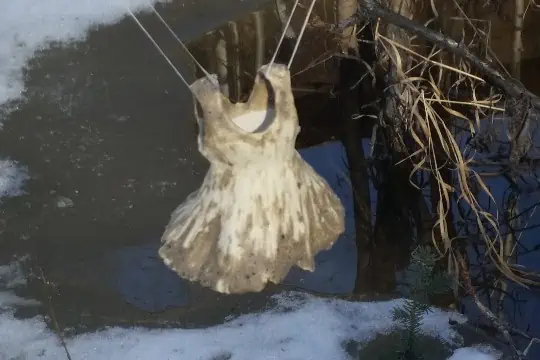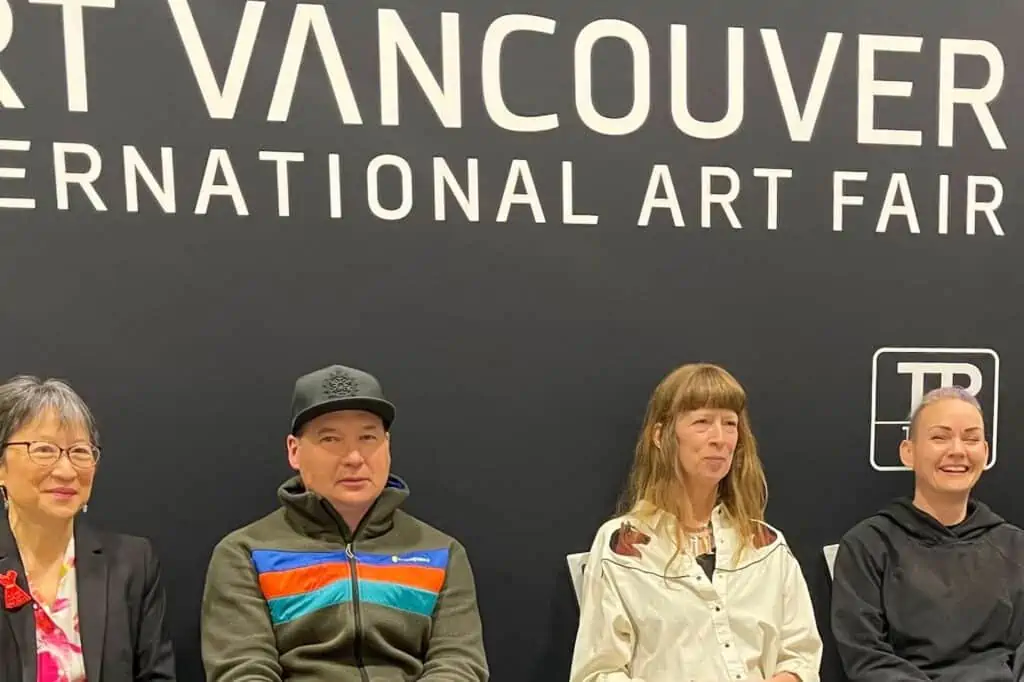All three exhibitions currently on display at the Yukon Arts Centre’s public art gallery have to do with colonization.
Joseph Tisiga: IBC 1st Hole: Death Prophecy Denied
Joseph Tisiga’s paintings in watercolour and acrylic surround an interactive mini putt course in IBC 1st Hole: Death Prophecy Denied to create a critique of the Canadian government’s negotiations with First Nations regarding land claims.
Tisiga’s show begins with a strong statement: “THE GAME CAN NOT BE WON” appears boldly brushed in black in all caps on 27 large old blueprints on the wall leading into the show.
An installation on worn out Astroturf includes a huge sleigh bed pierced with two pickaxes. A vintage glass case holds a chess board, the white pieces with headless horses and western rooks, the green ones with “Indian” figures and bears for horses. Small Coke bottles with rags sticking out with them look like Molotov cocktails.
Inside, Tisiga’s paintings evoke the fever dreams of a land claims negotiator. A speaker stands on a box of Brillo soap pads. Someone sprays chemicals on spirit houses. A figure hovers over a fire.
In addition to the paintings, installation transforms the space into a claustrophobic mini putt game.
The high space of the gallery is taken up by a yellowed canvas wall tent suspended from the ceiling.
Signs point in various directions, “Dirty water,” “Broken land,” “Mild inconvenience,” and so on.
You can use the crooked mallets to bat the black balls around, but most of the ramps leading up to the mouths of the plywood cut out faces are too narrow to putt the ball up.
How you would win this game and what the goal would be is not clear, but even the basic tasks are pretty impossible. It’s a game that cannot be won. It’s worth trying though, to feel the futility Tisiga is trying to convey.
Michael McCormack: Station
Michael McCormack’s show, called Station, uses photography and installation to explore communication and human presence at the edges of human habitation.
Station begins with three photographs mounted into tables. All three of them include oil-drum-like shapes, ubiquitous in the far north. Even the Quonset huts begin to look like oil drums.
Inside the show, three structures dominate the darkened space.
Percussive sounds and flickering lights project from five oil drums on the floor, making shapes on the wall.
Bluish flickering lights come out of a high, cache-like structure. On closer inspection, looking up through the diagonal slats that make up the walls, you can see a screen set into the cache’s ceiling, with a stream of arctic images flitting by too quickly to see their details.
All of these works were inspired by DEW (Distant Early Warning) line stations in the Canadian high arctic.
Josh Winkler: Cut Climb Conquer
Josh Winkler’s exhibit, Cut Climb Conquer, uses drawing, watercolour painting and printmaking to look at the history of American domination of nature in relationship to one particular Californian sequoia tree.
The first print in Winkler’s exhibit shows the Calaveras Big Trees State Park in California. Entitled by the Latin name for the sequoia tree, “Sequoiadendron giganteum,” we see trees and stumps in curious positions. The fact that this kind of print is called a “woodcut” seems apt.
A motor home is pulled up in front of the trees, towing an SUV with a boat on top. Cars and more RVs fill a parking lot beside a row of portable toilets. The trees are labelled: “Mother” is standing dead; “Chip” is a stump lying on its side; “Father” is lying down.
A cut through the middle allow the road to pass right through “his” trunk.
And then there’s also the “Discovery” stump. A graphite rubbing of this stump’s surface takes up the back wall of this exhibition and extends about 10 feet along the floor. This gives you a sense of its actual size and its rings. “Discovery Stump” gets one more woodcut. You can see the ladder up the back for visitors to climb up onto the stump’s surface.
More wood cuts and watercolour-embellished drawings tell the story of the “Mother of the Forest,” whose bark was stripped and reassembled at the Crystal Palace at the 1866 World Fair in London.
These three exhibits will continue to provoke thought at the Yukon Arts Centre gallery until May 28.




